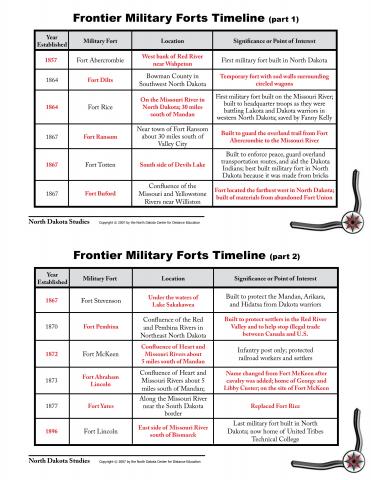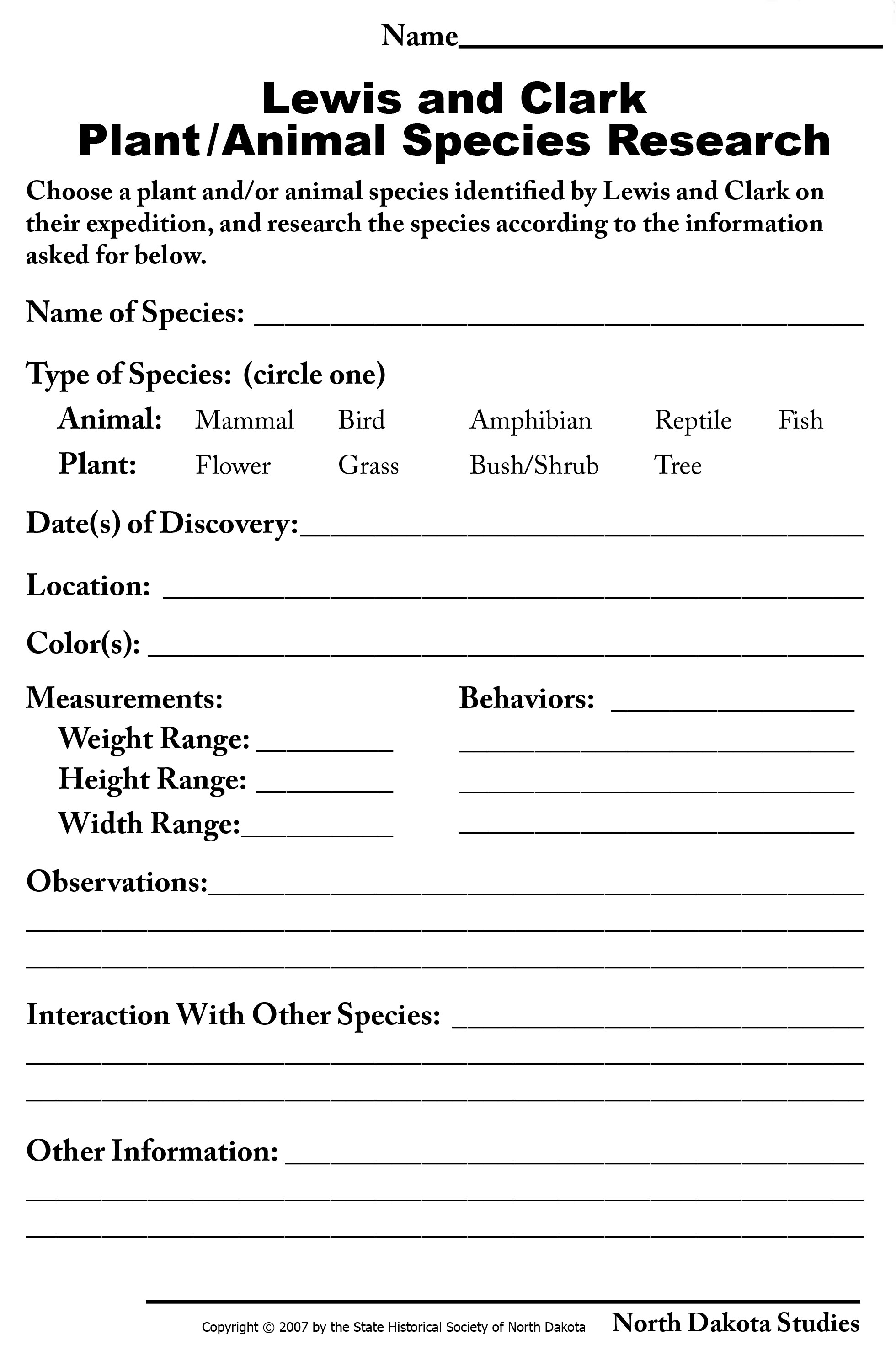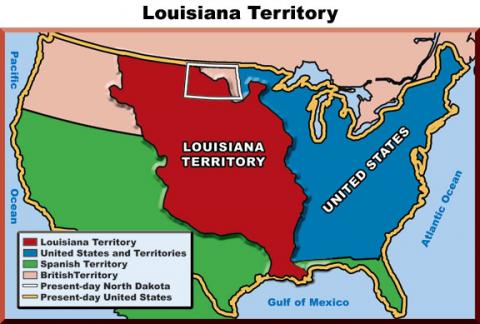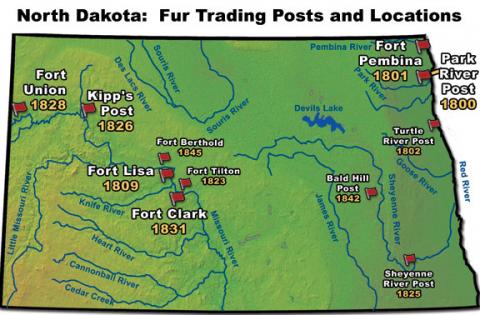Resources
Textbook
Teacher Resource Guide
The purpose of this Teacher Resource Guide is to assist the teacher in teaching about the Frontier Era of North Dakota. It is intended to be interdisciplinary and to act as a guide to supplement other activities that may be used in the classroom. Review and discussion questions, vocabulary, and additional activities are included and available in print and CD-ROM versions of the Teacher Resource Guide for Frontier Era of North Dakota.
Books
Have students create an ABC Alphabet Book on Lewis and Clark and the Corps of Discovery (e.g., A = Accuracy of Mapmaking, B = Beaver Hats, C = Corps of Discovery). Illustrate each page and share it with another classroom or place it in the school library.
Extension: Substitute with other topics such as Explorers of North Dakota, Fur Traders of North Dakota, or Military Life on the North Dakota Frontier.
Children's Literature Checklist
Have students create a timeline in book form of the Lewis and Clark Expedition through illustrations and explanations. An informative site follows. Other timeline books could include the fur trading and military forts established in North Dakota, along with relevant information for each.
Have students create an Explorer’s and Fur Trader’s Glossary with illustrations and definitions that younger children in lower grades could understand. Have students share with others in the classroom or place it in the school library for use by other students.
Have students create a book illustrating and describing 5–7 new animals, plants, sites, or people that the Lewis and Clark Expedition encountered.
Children's Literature Checklist
Have each student choose 3–5 things Sakakawea did that he/she thinks demonstrated courage or resourcefulness, and have each student illustrate them, adding a one-line caption to explain each picture.
Have students use vocabulary words to create a book or comic book of any part of the frontier life in North Dakota. Include words, definitions, and illustrations.
Children's Literature Checklist
Have students create a comic book on frontier military life in North Dakota.
Brochures
Have students design and produce a trifold brochure on historical sites in North Dakota related to the frontier era (e.g., forts, battleground sites, events, interpretive centers) to be used for tourism.
Have students create a brochure advertising the Corps of Discovery Expedition.
Debate Ideas
Isobel Gunn, also known as “John Fubbister,” disguised herself as a man to be allowed to work as an agent at a fur-trading post. Should women of that time period have been allowed to be a part of the fur-trading business? Research and debate the pros and cons of this topic.Extension: After the debate is completed, have the students exchange sides and debate the other side.
Responsibilities and roles of women in the military during the frontier era were non-existent. Women and children of the soldiers were called “camp followers” and did not have army privileges. The laundresses, however, received food, medical care, and other services of the fort. Was this fair? Debate the pros and cons of each side of the debate.
Sakakawea was said to have been instrumental in the success of the Corps of Discovery. Discuss the pros and cons of whether you think the Corps of Discovery expedition could have succeeded without Sakakawea.
Lieutenant Colonel George Armstrong Custer has been described as being reckless and leading his troops to death for his own glory. Debate this statement.
Diorama
Using a box about the size of a shoe box, have students create a diorama by replicating one day from the journals of Lewis and Clark.
Have students create a diorama of either a fur trading post, a military fort, or Fort Mandan.
Drawing
Have students draw items traded among the fur traders, Lewis and Clark, and the American Indians. Label each item and give each item a value that may have been used in bartering.
Have students draw a replica of a Red River cart along with a written explanation of how it was assembled. Extension: Have students create a model of the Red River cart out of supplies they have.
Have students draw an illustration of a typical steamboat found on the Red and Missouri Rivers. Research these steamboats for accuracy.
Using the following description written by Meriwether Lewis as he described a black woodpecker, have students follow the description given below to draw it, or have them partner up and have one student read the description as the other draws it.
- “He is about the size of the turtle dove.”
- “The beak is one inch in length, black, curved at the base and sharply pointed.”
- “The top of the head, the back, the sides, and the upper surface of the wing are glossy green.”
- “The tongue is barbed and pointed.”
- “The eye is rather large, the pupil black and the iris of a dark and yellowish brown.”
- “The tail is equipped with ten feathers.”
- “The legs and feet are covered with scales.”
- “He has four toes on each foot, two in the rear and two in the front.”
- “The nails are much curved and remarkably sharp.”
Have students illustrate a pirogue (type of canoe dug out from a log) and/or a keelboat (large, flat-bottomed boat used for hauling cargo).
Electronic Presentations
Have students create an iMovie, PowerPoint, movie, or another electronic media to illustrate and describe through text, animations, clip art, etc., 5–7 new animals, plants, sites, or people that the Lewis and Clark Expedition encountered.
Games
Have students create a Frontier Era of North Dakota Board Game (rubric below) using the frontier era questions provided in the Teacher Resource Guide.
Have students play these games using questions from the text: BINGO, Jeopardy, Wheel of Fortune, Trivial Pursuit, etc. (The following site is a wonderful site with templates, directions, and examples of Jeopardy, Who Wants To Be A Millionaire, or Hollywood Squares by using PowerPoint.) Suggested categories: Explorers of North Dakota; Fur Traders of North Dakota; Lewis and Clark and the Corps of Discovery; The Role of the American Indian and the Success of the Lewis and Clark Expedition; Military Life on the Frontier.
Frontier Era of North Dakota Bingo—Have students fill in the blank boxes with frontier era words provided below. Have a list of words created along with the definition and cut them into small pieces. The caller will select a card, read the definition, and the students will place a marker on the word that matches the definition. When BINGO is called, the student must read the word and give the definition before it is counted. Note: This may be used as an assessment tool.
Graphic Organizers
Have students produce a supply list of what the Corps of Discovery needed to get ready for the trip in the form of a mind map (example below). Divide the supply list into food, supplies, gifts for the Indians, weapons, etc. Under each category, give a brief explanation for including each item.
President Thomas Jefferson told Congress that the Corps of Discovery Expedition would cost $2,500. This amount was spent on supplies in St. Louis even before they had left. The total of the expedition came to $38,722.25. $15,000 was spent on supplies and salaries for the boatmen, and with each member of the Corps receiving a piece of land as a reward with the exception of York, the total topped $136,000. In today’s dollars, that’s more than $120 million. Have the students research what it costs to send astronauts to the moon or to outer space, and have them display graphically the costs of each expedition. Discuss whether or not the Corps of Discovery Expedition was a good investment.
Have students create a flow chart of the steps the laundresses in the military forts followed to wash clothes. Words or illustrations may be used to fulfill this task.
Have students graphically describe the classes of furs (fine and rough) through both words and illustrations.
Map Skills
Have students draw a map covering the journey of Lewis and Clark.
Have students locate on a North Dakota map the sites of each of the fur trading and military forts that were a part of North Dakota history.
Using a large U.S. wall map and research materials of Lewis and Clark, have the students research the general route of the expedition from North Dakota to the Pacific Ocean. In small groups, discuss the geography of each area and brainstorm ideas about how they used the natural resources of each area to meet their basic needs, as well as how they used different materials to make clothes. Have each group create an artifact of something the members of the group used or may have used to meet their basic need, and let them put it up on the map.
Montage/Collage
Have students find illustrations, words, descriptions, art, etc. to depict the life of a fur trader/trapper, an explorer, a soldier on the frontier, etc., and create a montage or collage to be glued on poster paper and displayed.
Poetry
Have students create poetry corresponding to the North Dakota Studies unit they are studying:
Couplets (two-line stanza that rhymes).
Triplets (three-line poems). A triplet may be written in the shape of a triangle and can be read by starting at any corner.
- Patterns include ABB (two of the lines rhyme)
- AAA (all three lines rhyme)
- ABC (no lines rhyme)
Haiku
- Line 1—five syllables
- Line 2—seven syllables
- Line 3—five syllables
Cinquain
- Line 1—one word (title)
- Line 2—two words (describe the title)
- Line 3—three words (describe an action)
- Line 4—four words (describe a feeling)
- Line 5—one word (refer back to the title)
Diamanté (Diamond)
- Line 1—one noun (subject #1)
- Line 2—two adjectives (describing subject #1)
- Line 3—three participles (ending in –ing, telling about subject)
- Line 4—four nouns (first two related to subject #1, second two related to subject #2)
- Line 5—three participles (about subject #2)
- Line 6—two adjectives (describing subject #2)
- Line 7—one noun (subject #2)
ABC Poetry (Start with A and go through the alphabet writing a word for each letter. You may make several sentences, but the information should be about North Dakota.)
Acrostic Poems (The first letters of the line spell out a word that has something to do with the poem.)
Lanterns (Japanese poem that is written in the shape of a Japanese lantern).
- Line 1—one syllable
- Line 2—two syllables
- Line 3—three syllables
- Line 4—four syllables
- Line 5—one syllable
Posters
Have students design and produce a poster advertising for recruits for the Corps of Discovery. Include qualifications needed by each applicant.
Have students create a poster showing what foods should be eaten to be completely healthy, compared with the diet, consisting mainly of meat, eaten by the members of the Corps of Discovery.
Have students create a poster showing what decorations, symbols, and colors were displayed on army uniforms for soldiers serving in the infantry, cavalry, and/or artillery during the frontier era.
Research Activities
Think, Pair, Share Activity on the Lewis and Clark Expedition. (This technique may be used for any topic.)
Thomas Jefferson told Captain Lewis to choose sturdy frontiersmen who knew how to live off the land. He warned Lewis not to take “young gentlemen.” Have each student think individually what traits or abilities would have been needed to be a member of the Corps of Discovery. Working in pairs, have students share their ideas and thoughts with each other. This enables the teacher to observe what knowledge the students have when thinking about the traits needed to be a member of the Corps of Discovery. Examples may include: responsible, courageous, ability to persevere, ability to adapt, good marksman, swimmer, ability to work with others, etc.
Have students think of and write down examples from their own lives in which they have recognized some or all of these characteristics in themselves.
Students may then share their thoughts or examples from their own experiences with a partner on one or all of the traits or abilities by writing down their ideas on the board and/or poster paper for the entire class to see and to discuss.
Lewis and Clark’s journals mention the Corps engaging in fiddle music, singing, and European dances such as the jig and the reel. Have students research, learn, and dance a jig or reel.
State Historical Society of Noth Dakota
Lewis and Clark Online Exhibit
Have students research the various spellings of Sakakawea (i.e., Sacagawea, Sacajawea). The Bureau of American Ethnology established her name in 1910 as “Sacagawea,” spelling used by the Encyclopedia Americana, World Book Encyclopedia, the U.S. Geographic Name Board, the U.S. National Park Services, and numerous history scholars.
Have students research the lives and works of George Catlin, Prince Maximilian, Karl Bodmer, and John James Audubon, who were visitors to the Upper Missouri. Web links are found at the link below or on the CD-ROM with the Teacher Resource Guide to aid the students in their research.
Missouri River Steamboats and Visitors
Assign individuals or small groups to research and demonstrate their knowledge of the frontier era of North Dakota through one of the formats listed below. Examples include:
Treaties and Settlers
Research the military forts in North Dakota (origin of name, location, function, etc.) and share with the class.
Fur Trade on the Red River
Research the fur trading forts in North Dakota (origin of name, location, function, etc.) and share with the class.
Beaver pelts were used extensively in Europe in the 18th and 19th century for the manufacture of hats. Research the importance of the beaver hat using one of the choices listed below (include descriptions of the different styles of hats and techniques used to process the furs into finished hats):
Report, radio broadcast, bulletin board, slide presentations, student-generated tests of material, PowerPoint or iMovie, news reports, oral histories of events, interviews, dramatize legends and myths, commercials, jump rope rhymes/poetry, plays, role plays, song writing, tv talk shows, weather reports, tongue twisters, maps, mobiles, brochures, crossword puzzles, illustrated and written book, scrapbooks, timelines, cartoons, model or diorama
Small Groups
Have students research, write, and perform a short play about some part of the Lewis and Clark Expedition. Puppetry could also be used. Divide the students into small groups and have them choose an area of the Lewis and Clark Expedition that interests them. Choices of what to perform should include the time spent in North Dakota both going to and coming back from the Pacific Ocean.
Have students imagine they are explorers or fur traders. Have each group make a list of all the food, clothing, and other goods it would bring along for use during their trip. It is important they remember to bring only what they can carry. Have them give a reason for each item, and make another list of the things they would obtain from the American Indians or from nature. Present to the class in the form of a report, chart, or other method of delivery as listed previously.
The Métis had strict rules that all people participating in the bison hunt were required to follow. They were:
- No bison could be killed on Sunday.
- No group of hunters could go ahead of or fall behind the rest of the hunters.
- No group of hunters could go after the bison without all the rest of the hunters.
- Every group of hunters had to take its turn in guarding the camp against attack.
- The first time anybody broke one of these rules, his saddle and bridle were to be cut up.
- The second time anybody broke one of these rules, his coat was to be cut up.
- The third time anybody broke one of these rules, he was to be whipped.
- Anybody who was caught stealing, even if the thing stolen was of no value, was to be brought to the center of the camp where his name was to be called out loudly three times. Each time his name was called out, the word “thief” was to be added to it.
Have students discuss in small groups why they think these rules were necessary. What would happen to the bison hunt if many people disobeyed the rules? Share with the class.
Have students research some of the gestures Sakakawea made to communicate with both those of her own tribe and those from other tribes (e.g., sucking her fingers, throwing the blanket around her brother, painting their cheeks red). Then ask them to get into pairs of two and think of some of the gestures we use today to communicate with one another (e.g., shaking hands, waving, kissing on the cheek, or pointing at certain things like our ears to indicate that we can’t hear). Finally have each group pair up with another group to share their ideas. Each group will then share three of their ideas with the class.
Bartering Activity: Divide students into three communities (i.e., farming community, hunting community, trading post) and assign each student a community. Discuss the meaning of trading, or bartering. Each group will be provided with a product list from those listed below. Students will find clip art, cut out pictures from magazines, or illustrate the product on a card. The card will be attached to a string that can then be worn as a necklace for ease in trading. Each group also needs to create three additional products that the group thinks will be needed to survive the winter at a trading post. Each student will then individually select one item to trade from the product list and/or the additional products. The remaining cards will remain as their community’s supply. After a period of time determined by the classroom teacher, have each student trade one item at a time with another community. Remind the students that they have the right to either accept or reject an offer to trade an item if they feel it is not a fair trade. Have students come back together and, as a group, display and review their products and discuss if they thought they would have enough of the right products to survive the winter.
- Farming Community (dried beans, dried squash, wild prairie turnip flour, dried corn)
- Hunting Community (bison meat, bison hides, beaver pelts, horses)
- Trading Post (copper kettles, beads/buttons, weapons, trade blanket)
Symbols
Have each student create a peace medal to share with others as Lewis and Clark shared peace medals with the American Indians they encountered. Extension: Have each student explain in writing what symbols were used in his/her peace medal and the significance of each symbol.
Timelines
Create a timeline for the Lewis and Clark Expedition using illustrations and/or words. Consult the following websites as resources:
Have students (individually, in pairs, or in small groups) complete timelines for either the fur trading forts and/or the military forts in North Dakota.
Have students (individually, in pairs, or in small groups) write a significant event on an index card relating to the frontier era of North Dakota or to the Lewis and Clark Expedition. Take turns placing the cards in the correct sequential order. Students creating the timeline should create an answer sheet to check for understanding of the students participating.
Venn Diagrams
Using the Venn Diagram found below, show the differences and similarities of the food eaten by a party of explorers or fur traders and the food we eat today. Research what these men took on expeditions. This activity would lend itself nicely to a small-group activity, as well.
Compare and contrast a fur trading fort with a military fort.
Vocabulary/Spelling
Students may partner up and give each other a spelling test (written and/or oral).
Using the worksheet provided in the Teacher Resource Guide, decode the misspellings of Lewis and Clark’s journal entries.
Vocabulary Cards: These cards may be used as game cards or other methods of review (found in Teacher Resource Guide).
Writing Activities
Have students assume the role of a member of the Corps of Discovery (Lewis, Clark, York, Cruzatte, Sakakawea, etc.) and have them write a journal entry from that person’s point of view.
Have students read the journal entries of Lewis and Clark found at the following site and find the incorrect spellings, punctuation, capitalization, and sentence structure for several of the entries. In addition, have them write what Lewis or Clark would have written had they used correct grammar.
Lewis & Clark's Historic Trail: Journals
Lewis and Clark were co-captains of the expedition to explore the Louisiana Territory. Yet, it was recorded that not one time did they ever argue or disagree on an important decision. Have students write what they could learn from Lewis and Clark in how to work together with their classmates and/or siblings.
Have students imagine they are explorers writing letters to their families in Europe. Have them describe their impressions of the first bison herd they saw. In addition, have them provide illustrations.
Have students dip writing paper into tea and let it dry to replicate old-looking writing paper. Next, have them pretend they are explorers or fur trappers. Have students each write a diary page describing a day in the life of an explorer or fur trapper. Encourage them to be descriptive so the reader feels he/she is actually with them on their trip.
Have students visualize and describe their thoughts and feelings when they were leaving Fort Abraham Lincoln under the leadership of Lieutenant Colonel George Armstrong Custer to meet the Lakota warriors. In addition, have them describe their thoughts and feelings after they had encountered the enemy.
Women, during the frontier era, did not want to have suntans, as this was considered shameful. If this were to be the fashion today, have the students describe how each one would feel about it. What would they do? Would they follow what everyone else was doing, or would they do their own thing? Have them explain their answers. This activity could be placed in a T-Chart or Venn Diagram.
The women at military forts followed strict social rules. For example, the officers’ wives thought they were better than the other women, and the wives of enlisted men thought they were better than the laundresses. Have the students write how they would have felt as an officer’s wife, an enlisted man’s wife, or a laundress. Have them describe their feelings.
Have students imagine it is the year 2204; they have traveled back 400 years to meet Lewis and Clark at Ft. Mandan. But there is a problem, as Lewis and Clark don’t believe them! Have the students write how they would persuade Lewis and Clark that they are really from the future. What will they tell them to persuade them? Write what they see, and describe what they think it is like living 400 years in the past.
Explorers and Fur Traders
Upper Missouri Visitors
Lewis and Clark Expedition
Military Life
Literature
| Authors | Titles |
| Adler, D.A. | A Picture Book of Lewis and Clark |
| Blumberg, R. | The Incredible Journey of Lewis & Clark |
| Clark, E.E. and Edmonds, M. | Sacagawea of the Lewis & Clark Expedition |
| Copeland, P.F | The Lewis and Clark Expedition Coloring Book |
| DeVoto, B. | The Journals of Lewis and Clark ISBN: 9780395859964 |
| Edwards, J. | Lewis and Clark’s Journey of Discovery In American History |
| Erdrich, L | Sacagawea |
| Fifer, B. | Going Along with Lewis and Clark |
| Gunderson, M. | Cooking on the Lewis and Clark Expedition |
| Herbert, J. | Lewis and Clark for Kids: Their Journey of Discovery with 21 Activities |
| Hunsaker, J.B. | They Call Me Sacagawea |
| Jenkinson, C.S. | A Lewis and Clark Chapbook: Lewis and Clark in North Dakota |
| Johmann, C.A. | The Lewis & Clark Expedition: Join the Corps of Discovery to Explore Uncharted Territory |
| Jones, L.Y. | The Essential Lewis and Clark ISBN: 9780060011598 |
| Karwoski, G.L. | Seaman: The Dog Who Explored the West with Lewis & Clark ISBN: 1561451908 |
| Kiesling, S.P. | The Lewis & Clark Expedition |
| Kroll, S. | Lewis and Clark: Explorers of the American West |
| Morley, J. | Across America: The Story of Lewis & Clark |
| Morley, J. and Watts, F. | America: The Story of Lewis and Clark |
| Phillips, H.W. | Plants of the Lewis & Clark Expedition |
| Roop, P. and C. | Off the Map: The Journals of Lewis and Clark |
| Rowland, D. | The Story of Sacajawea: Guide to Lewis and Clark |
| Schanzer, R. | How We Crossed the West: The Adventures of Lewis & Clark |
| Steenwyk, E.V. | My Name is York |
| Stein, R.C. | The Story of the Lewis and Clark Expedition |
| Lewis and Clark: Cornerstones of Freedom | |
| Thomasma, K. | The Truth About Sacajawea |
| Videos |
|---|
| Inspiring Journey: Lewis and Clark Through the Eyes of the Artist, Part 1: The Art of the Expedition, Ron Ukrainetz, narr., Crizmac Art & Cultural Education Materials, Inc. ISBN: 0-945666-88-8 |
| Lewis and Clark: Explorers of the New Frontier, A&E Biography Home Video |
| Lewis & Clark at Fort Mandan, Darrell Dorgan, North Dakota Lewis & Clark Bicentennial Foundation |
| Lewis & Clark: Great Journey West, Jeff T. Miller and Lisa Truitt, National Geographic Society. |
| Lewis and Clark: The Journey of the Corps of Discovery, Ken Burns, PBS Home Video, 2 Parts |
| Lewis and Clark Pathways, Amy Mossett, narr., Prairie Public Broadcasting |
| The Journey of Sacagawea, PBS Home Video |
| Music (CDs) |
|---|
| Lewis & Clark: Sounds of Discovery, Various artists, Makoché. An ambitious survey of the expedition. |
| Listening to Lewis & Clark: Dispatches from the Voyage of Discovery, Thomas Schmidt, Bridger Press. Two CDs include journal excerpts, original music, and sound effects. Thomas Schmidt offers an introduction and narrative commentary of the expedition approximately two-and-a-half hours in length. |
| People of the Willows, various artists, Makoché. Modern presentation of Mandan and Hidatsa traditional melodies. |























